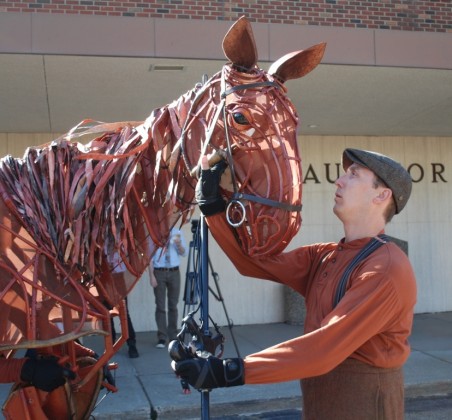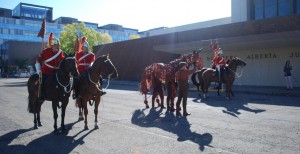War Horse a masterful display of equine puppetry
Posted on September 17, 2013 By Mike Ross Entertainment, Front Slider, Theatre
 The fake horse was so real that even the real horses were fooled. They wouldn’t get near the thing.
The fake horse was so real that even the real horses were fooled. They wouldn’t get near the thing.
And these were trained military steeds from the Strathcona Mounted Troop, no less, a bit freaked out during Tuesday’s photo op for “War Horse,” leading to the play’s run through Sept. 22 at the Jubilee Auditorium. As their uniformed riders took them close, the horses shied away from the equine monstrosity that is the play’s namesake, obviously nervous, spooked. One apparently wanted to kick the thing, which is operated by three puppeteers who were very careful not to express any aggressive behaviour. Horses can pick up on that sort of thing.
One guy works the front, one works the back and a third is the “handler” who uses a trigger mechanism to move the ears and head. The overall effect is uncanny, a little spooky even if you’re human. And in case anyone is wondering – hey, we ask the dumb questions so you don’t have to – they do not simulate horse pooping.
“We drew the line there,” explains Edmonton performer Dayna Tietzen, one of the puppeteers who plays the hind end, and once again with the dumb questions, “There isn’t a joke that we haven’t heard at this point.”
There is a serious story behind the masterful equine puppetry. A boy sets off to France during WWI to find his lost horse Joey, which had been enlisted to fight with the British and had gone missing in action. With live music, special effects and a team of other puppeteers portraying various birds, this an emotional tale that needs an expressive star – in this case a puppet horse capable of a remarkable emotional range.

This is as close as we’re getting!
The ears and tail particularly telegraph a wide range of equine emotions, Tietzen says. Joey – created over several years by the Handspring Puppet Company, which won a Tony award for its work – even simulates a horse’s breathing. Small knee bends from one of the puppeteers trigger an expanding ribcage, with sharp short breaths in times of stress, which given the subject matter, the play has a lot of. The three puppeteers together emulate most of the horse sounds, including a very convincing whinny mainly accomplished while inhaling – a “voice teacher’s nightmare,” as one of the puppeteers put it.
The main goal with this unusual star character since War Horse opened on Broadway in 2007 – having since split into touring companies around the world – is that you have to pretend you’re dealing with an animal actor. Tietzen, who was trained in ballet before moving onto musical theatre, explains, “We did a lot of research when we were doing the show, a lot of looking at real horses to see how they react. The biggest thing was not to act like humans or give them human thoughts, not put anything onto them, and have them react as animals. Horses have this real fight or flight instinct in them, so we try to be as true to that as possible.
“As puppeteers, our greatest goal to make you believe we’re alive and forget we’re a puppet.”
Mission accomplished – at least for some observers.












